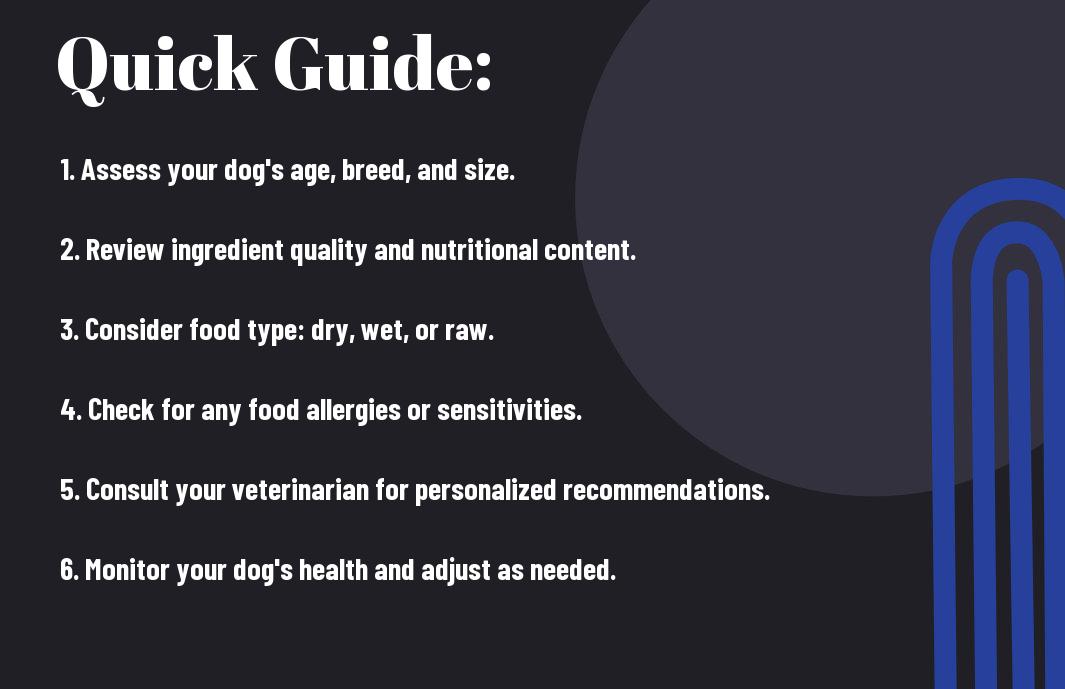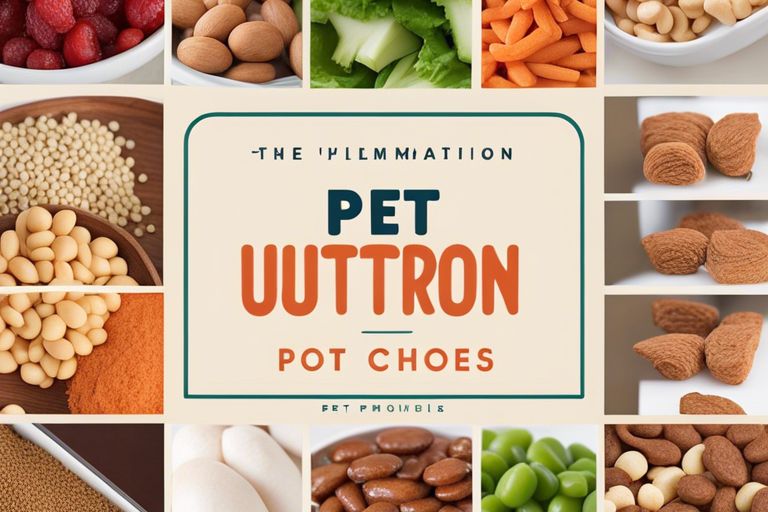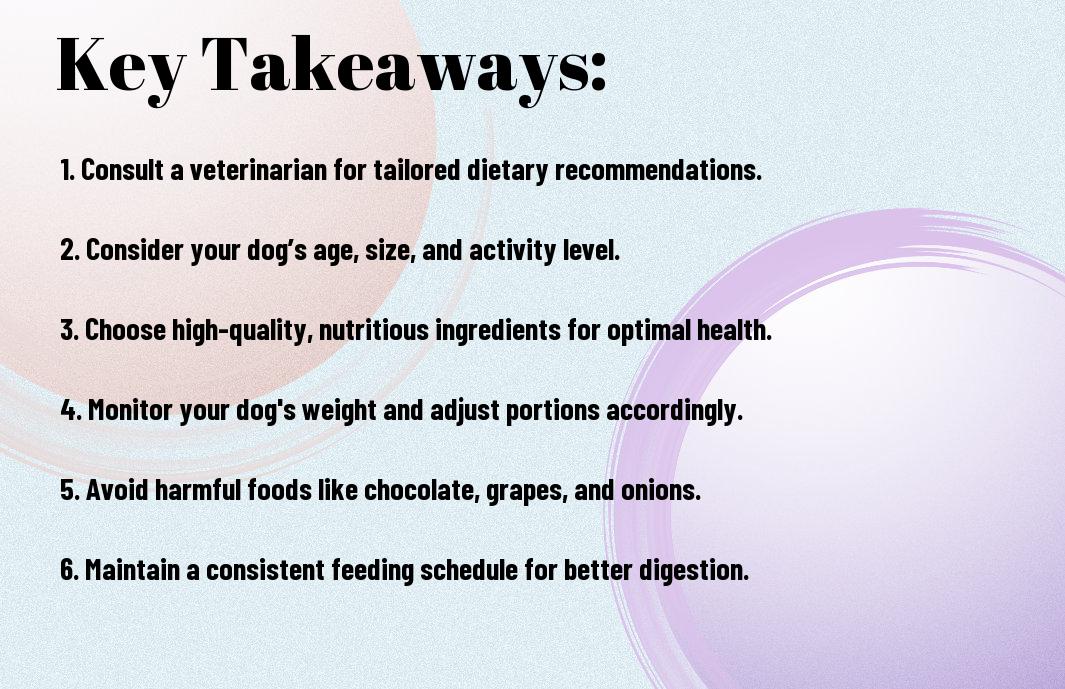Over the years, selecting the right dog food has become increasingly overwhelming, given the multitude of options available. It’s crucial for you to understand the nutritional needs of your dog, as well as the potential health risks associated with poor dietary choices. This guide will equip you with the knowledge to make informed decisions about high-quality dog food that not only meets your pet’s specific requirements but also promotes their overall well-being. Your dog’s health starts with their diet, making it imperative to choose wisely.

Understanding Dog Food
Before you make any decisions regarding your dog’s food, it is vital to understand the different options available. The right dog food can significantly impact your pet’s overall health, energy levels, and longevity. The complexity of dog food can be daunting, but breaking it down into simpler components will help you make an informed choice that suits your pup’s individual needs.
Types of Dog Food
While there are various types of dog food on the market, each offers specific benefits and drawbacks. Below is a table to help you distinguish between the key types:
| Type | Description |
| Dry Food (Kibble) | Convenient, cost-effective, and helps maintain dental health. |
| Wet Food (Canned) | Higher moisture content, often more palatable; consider for picky eaters. |
| Raw Diet | Natural, whole foods which can include raw meat, bones, and vegetables. |
| Dehydrated Food | Less processed, retains nutrients; needs water added before serving. |
| Homemade Food | Customizable to your dog’s specific needs, but requires careful planning. |
Recognizing the benefits and potential risks associated with each type of food will help you tailor a diet that meets your dog’s specific health needs and preferences.
Ingredients to Look For
If you want to ensure that your dog is receiving the best nutrition possible, examining the list of ingredients is vital. Look for high-quality animal proteins listed as the first ingredient, as they are vital for muscle development and overall health. Additionally, you should consider sourcing foods that include whole grains, fruits, and vegetables, as these can provide necessary vitamins and minerals.
To further enhance your dog’s diet, consider including options that feature natural preservatives, such as tocopherols, instead of artificial ones. Ingredients like Omega-3 fatty acids promote healthy skin and coat, while glucosamine supports joint health. Avoid dog foods that contain unknown meat by-products, artificial flavors, or fillers, as these can be detrimental to your dog’s health. Your dog’s well-being depends on providing a balanced diet filled with wholesome, nutrient-rich choices.

Factors to Consider When Choosing Dog Food
After deciding to bring a dog into your life, one of the most important choices you’ll face is selecting the right food. The right dog food will support your pet’s health, energy levels, and overall well-being. To help you make an informed decision, here are some key factors to consider:
- Dog’s Age and Life Stage
- Breed-Specific Nutritional Needs
- Allergies and Sensitivities
- Activity Level and Lifestyle
Dog’s Age and Life Stage
Clearly, your dog’s age and life stage should significantly influence your choice of food. Puppies have different nutritional needs compared to adult dogs and seniors. For example, puppy food is designed to support growth and development, typically containing higher levels of protein and calories which are crucial for their rapid growth. On the other hand, senior dogs require diets lower in calories but enriched with joint-supporting nutrients.
Choosing food that aligns with your dog’s life stage not only promotes healthy growth but can also help in preventing potential health issues. As your dog transitions through different life stages, be sure to adjust their diet accordingly to meet their changing nutritional needs.
Breed-Specific Nutritional Needs
One of the significant considerations when selecting your dog’s food is their breed-specific nutritional needs. Different breeds come with varied health issues and metabolic rates, thus requiring tailored diets. For example, large breed dogs often need food that supports bone health and growth, while smaller breeds may benefit from recipes that are formulated for their higher metabolism and smaller jaws.
Considering your dog’s breed can guide you to participate in the right nutritional regimen. Some breeds may benefit from food enriched with certain vitamins or minerals to address their specific health considerations, such as hip dysplasia in larger dogs or dental issues in smaller breeds.
Plus, you should pay attention to the quality of ingredients used in breed-specific formulas. Prioritizing dog food that includes high-quality protein sources and avoids fillers can promote better overall health for your furry friend.
Allergies and Sensitivities
BreedSpecificx signs such as itchy skin, gastrointestinal issues, or chronic ear infections can indicate that your dog may have food allergies or sensitivities. It’s important to identify any potential allergies as they can affect your dog’s quality of life. Many dog foods are now formulated to be hypoallergenic, which can help in alleviating uncomfortable symptoms caused by certain ingredients.
When choosing a dog food for an allergic dog, look for options with limited ingredients, as these formulations reduce the number of potential allergens. This approach allows you to pinpoint what ingredients work for your dog without triggering any adverse reactions.
This attention to allergies can make a world of difference in your dog’s comfort and happiness. Providing a diet that avoids allergens can lead to a healthier, happier pet.
Activity Level and Lifestyle
Activity plays a significant role in determining your dog’s dietary needs. A highly active dog will require food that is rich in calories and high-quality protein to maintain their energy levels, while more sedentary dogs might thrive on a diet lower in fat and calories. Adjusting your dog’s food based on their activity level ensures that they maintain a healthy weight and energy balance.
Furthermore, life circumstances, such as whether your dog participates in sports, exercises daily, or enjoys leisurely walks, will also guide food selection. Understanding these elements helps in providing the optimal diet suited to your dog’s lifestyle.
Nutritional choices impact your dog’s health, energy levels, and longevity. Feed them the right amount tailored to their activity level to prevent weight gain and promote an active life.
Tips for Selecting the Right Dog Food
For pet owners, selecting the right dog food is vital for your furry friend’s health and well-being. The multitude of options available can be overwhelming; however, utilizing specific strategies can help narrow down your choices. Here are some tips to guide you through the selection process:
- Choose high-quality ingredients that meet your dog’s nutritional needs.
- Consider your dog’s age, size, and activity level.
- Read the ingredients list carefully to understand what you are feeding your dog.
- Examine the nutritional adequacy statement to ensure the food is complete and balanced.
- Consult reviews and ratings to gauge the reputation of the brand.
Recognizing the importance of these factors can set you on the right path to finding nutritious food for your dog.
Reading Labels Effectively
Tips for reading dog food labels include familiarizing yourself with the ingredients that should be present. Look for recognizable sources of protein, such as meat or fish, and avoid foods with ambiguous terms like “meat by-products.” Additionally, check for the presence of artificial additives or fillers, as these can be detrimental to your dog’s health.
In addition, pay attention to the order of ingredients on the label; the first few should consist of high-quality proteins and whole grains. Ingredients are listed by weight, and the first ingredient is usually the predominant source, so ideally, your dog’s food should have a named protein source at the top of the list. This will help you determine if the food meets your dog’s dietary needs.
Understanding Guaranteed Analysis
Effectively, the guaranteed analysis on dog food packaging provides a breakdown of the nutrient content, including percentages of protein, fat, fiber, and moisture. This information helps you compare different foods and ensure they meet your dog’s specific dietary requirements. For example, puppies may need higher protein levels for growth, while senior dogs might need lower fat content.
A thorough understanding of guaranteed analysis allows you to make informed choices about your dog’s food. By observing these percentages, you can tailor your dog’s diet to their stage of life, keeping in mind that individual dogs may have unique needs based on their health conditions and lifestyle.
Researching Brands and Ingredients
Reading about different dog food brands and ingredients can provide you with insights into the quality and reliability of the products available. Look for brands that are transparent about their sourcing practices and provide detailed information regarding their ingredients. A strong reputation among consumers can also indicate a trustworthy brand.
Researching ingredient sources is just as important; seek out companies that prioritize whole foods and avoid fillers. Check if they utilize ingredients with high nutritional value, as these can contribute to your dog’s overall health. Ingredients like sweet potatoes, quinoa, and real meats can be great indicators of quality dog food.
Consulting with a Veterinarian
There’s no substitute for professional advice, and consulting with a veterinarian can be a game-changer in selecting the right dog food for your pet. Your vet can help you assess your dog’s specific nutritional needs based on their breed, age, weight, and health status. They may recommend specific brands or formulas that have a proven track record for similar dogs.
For instance, if your dog has allergies or specific health conditions, your veterinarian might suggest specialized diets that address these issues. This personalized guidance ensures that you’re providing your dog with the best possible nutrition tailored to their needs.

Step-By-Step Guide to Transitioning Dog Food
All dog owners want the best for their furry companions, and transitioning to a new dog food can be an important step in providing optimal nutrition. A gradual and well-planned approach ensures your dog adapts comfortably and without digestive upset. Below is a concise guide that will take you through the steps of changing your dog’s food.
| Step | Description |
| 1. Assessing Current Diet | Evaluate your dog’s current food, looking at ingredients and nutritional value. |
| 2. Choosing the New Food | Select a high-quality dog food that meets your dog’s specific needs. |
| 3. Gradual Introduction Process | Slowly mix the new food with the old food over several days. |
| 4. Monitoring for Reactions | Observe your dog for any negative reactions or changes in health. |
Assessing Current Diet
Now is the time to examine your dog’s current diet closely. Look at the ingredients list and nutritional values to get an idea of what you’re currently feeding your pet. Pay attention to any food sensitivities or specific dietary requirements, including age, weight, and health conditions, that may dictate a need for a different diet.
By understanding what your dog is currently eating, you can make informed decisions about the new food you will be transitioning to. If your current dog food lacks adequate nutrients or includes low-quality ingredients, this will guide you in selecting a more suitable option for your pet.
Choosing the New Food
There’s a wide variety of dog foods available, and the choice can feel overwhelming. After evaluating your dog’s unique needs, look for a food that lists high-quality sources of protein, fats, and carbohydrates. Check for certifications from reputable bodies and consider options that have undergone feeding trials.
Choosing a food that is appropriate for your dog’s breed, age, and lifestyle will ensure they receive balanced nutrition. Read reviews and consult with your veterinarian if you have questions about the suitability of a specific brand or formula for your dog.
To further ensure you’re making the right choice for your dog, consider factors such as ingredient sourcing, manufacturing processes, and how the food fits into your budget. Additionally, trying sample sizes or starter packs can help assess how well your dog likes the new food before committing to a larger purchase.
Gradual Introduction Process
Now, it’s vital to implement a gradual introduction process when switching your dog’s food. A sudden switch can lead to gastrointestinal upset, so gradually mix the new food with the old food over a period of 7 to 10 days. Start with 25% new food and 75% old food, then gradually increase the proportion of new food each day.
This controlled approach minimizes any risks of digestive distress and helps your dog adjust to the new flavors and textures smoothly. Pay close attention to how your dog reacts to this transition as you blend the two foods together.
Plus, keeping a consistent feeding schedule during the transition can also help stabilize your dog’s digestive system. Ensure that you maintain a calm environment during mealtimes to promote positive associations with the new food.
Monitoring for Reactions
One of the pivotal steps in transitioning your dog’s food is monitoring for any adverse reactions. During the transition period, take note of any changes in your dog’s behavior, stool consistency, or overall energy levels. Watch for symptoms such as vomiting, diarrhea, or loss of appetite, which could indicate an intolerance to the new food.
It’s important to be vigilant and responsive during this phase. If you notice any concerning reactions, consult your veterinarian to discuss whether you may need to revert to the old food or try a different new food that is better suited for your dog’s individual needs.
A thoughtful transition not only helps with your dog’s acceptance of the new food but also contributes greatly to their overall health and well-being. Ensuring your dog enjoys their new food can improve their mood and vitality, fostering a happier life for both of you.
Pros and Cons of Different Dog Food Types
Keep in mind that each type of dog food has its own set of advantages and disadvantages. Evaluating these can help you make informed decisions when choosing the right food for your dog.
| Dog Food Type | Pros and Cons |
|---|---|
| Dry Kibble | Pros: Convenient, cost-effective, long shelf life. Cons: May contain preservatives, lower moisture content. |
| Wet or Canned Food | Pros: Higher moisture content, more palatable for picky eaters. Cons: Often more expensive, shorter shelf life once opened. |
| Raw Diets | Pros: No fillers or preservatives, mimics a natural diet. Cons: Requires careful handling, potential for nutritional imbalance. |
| Specialty Diets (e.g., Hypoallergenic) | Pros: Tailored for specific health issues, can improve overall well-being. Cons: More expensive, may not be widely available. |
| Homemade Diets | Pros: Complete control over ingredients, can be tailored to your dog’s needs. Cons: Time-consuming, potential for nutrient deficiency. |
Dry Kibble
Kibble is a popular choice for dog owners due to its convenience and cost-effectiveness. It’s easy to portion, store, and serve, making it a practical option for busy lifestyles. Many kibble brands also come fortified with vital vitamins and minerals, ensuring your dog receives a balanced diet.
However, it’s important to note that some dry kibble can contain preservatives or fillers, which may not be beneficial for your dog’s health. Additionally, dry kibble has a lower moisture content, which may not be ideal for dogs that are prone to urinary issues or dehydration.
Wet or Canned Food
An alternative to dry kibble, wet or canned food offers several benefits, including a higher moisture content that can be beneficial for hydration. Many dogs find wet food to be tastier, making it an excellent option for picky eaters or dogs with a decreased appetite.
Despite its advantages, wet food can be more expensive than kibble and may have a shorter shelf life once opened. If you choose this type, be aware of the nutritional adequacy and whether it meets your dog’s specific requirements.
A wide variety of wet or canned food options are also available, catering to specific dietary needs or preferences. However, be cautious about choosing products with high sodium content or artificial additives, as these can be detrimental to your dog’s health.
Raw Diets
There’s been a growing interest in raw diets among dog owners, which focus on feeding your dog uncooked meat, bones, and vegetables. Proponents argue that this type of diet mimics what wild canines eat, providing natural nutrients that can lead to improved coat quality and enhanced overall health.
Nonetheless, raw diets require careful planning and handling to avoid contamination, and there is a risk of nutritional imbalances if not balanced properly. It’s crucial to research or consult with a veterinarian before committing to a raw feeding regimen.
Different formulations of raw diets exist, including the prey model, BARF (biologically appropriate raw food), and commercial raw foods. Each of these has its own benefits and drawbacks, and you’ll want to ensure your dog’s diet is nutritionally complete.
Specialty Diets (e.g., Hypoallergenic)
Some dog owners may find that their pets have specific health concerns that necessitate a specialty diet. Hypoallergenic diets, for instance, can help alleviate food allergies or sensitivities. These diets often contain limited ingredients, which can help identify and remove allergens from your dog’s diet.
While specialty diets can be effective in addressing health issues, they are typically more expensive and may require veterinary approval. It’s important to make sure that any specialty food you choose is suitable for your dog’s specific health conditions.
This type of diet often comes with extensive guidelines and recommendations, so working closely with your vet is paramount. They’ll help ensure that your dog’s nutritional needs are met while managing any health concerns.
Maintaining Your Dog’s Nutrition
Not only does maintaining your dog’s nutrition require careful selection of food, but it also involves ongoing attention to their health and behavior. Regularly monitoring how your dog responds to their diet is crucial for ensuring they’re receiving the proper nutrients for their specific needs. This vigilance can make a world of difference, particularly as your dog ages or experiences changes in lifestyle or health.
Tracking Changes in Health and Behavior
To effectively track changes in your dog’s health and behavior, you should establish a baseline to compare against. Keep notes on their weight, energy levels, coat condition, and any behavioral shifts. Notice if they seem more lethargic than usual or if there’s a shift in their appetite; these could be signs that their current food isn’t meeting their nutritional needs.
Additionally, consult with your veterinarian regularly to discuss your observations. Your vet can help you interpret any changes and suggest necessary modifications to your dog’s diet. This collaborative approach will help you stay proactive in ensuring your dog thrives.
Adjusting Portions and Types Over Time
To maintain optimal nutrition for your dog, adjusting portions and types of food over time is necessary. As your dog ages or if their activity levels change, so should their daily caloric intake. Younger dogs will require more energy to fuel their growth, while seniors often need less. Additionally, consider any health issues such as allergies or digestive sensitivities that could necessitate a switch in the type of food.
Your vet may recommend specific guidelines tailored to your dog’s needs, including weight goals and dietary preferences. If you notice your dog gaining or losing weight unexpectedly, do not hesitate to refine their portion sizes or even try a different type of dog food that aligns better with their evolving requirements.
| Indicator | Action |
| Weight change | Adjust portions |
| Energy level | Modify activity or food type |
| Coat condition | Consider different protein sources |
| Behavioral shifts | Review food ingredients |
- Monitor your dog’s overall health
- Consult with your veterinarian
- Adjust portions based on activity level
- Change food types if issues arise
- Track changes consistently
Types of food suitable for your dog can vary significantly, and understanding these differences will help you make informed decisions. Factors to consider include breed, size, and any dietary restrictions, all of which can influence the type of food that is most beneficial for your pet. Premium ingredients and special formulations can often aid dogs with specific health issues, ensuring they receive the nutrients they need.
| Food Type | Considerations |
| Dry kibble | Convenient and cost-effective |
| Canned food | Higher moisture content |
| Raw diet | Natural but requires careful handling |
| Specially formulated | Address specific health needs |
| Grain-free | For sensitive digestion |
- Evaluate food options based on effectiveness
- Take into account your dog’s preferences
- Be aware of potential allergens
- Research brands and ingredients
- Make adjustments as necessary
Staying Informed on New Research and Trends
Adjusting your understanding of canine nutrition is crucial as veterinary science continually evolves. New research frequently emerges, shedding light on dietary needs, ingredient safety, and even food-related health concerns. Staying proactive means regularly checking credible sources for the latest findings that might affect your dog’s diet.
By seeking out reliable information and trends, you can ensure that your dog benefits from the best available nutrition. Consulting your veterinarian about new studies can help you interpret how these findings apply to your dog’s specific needs.
Trends in dog food nutrition often highlight *positive* changes in ingredients and formulations that can enhance your dog’s overall health. For instance, many pet owners are now gravitating towards foods that are free from *artificial additives* and filled with high-quality proteins or *whole foods*. Understanding these trends can influence your decisions about the food you select. Always be cautious about potential dangers, such as emerging allergens or recalls, and incorporate this knowledge into your regular reviews of your dog’s diet.
Conclusion
So, as you begin on the journey of choosing the right dog food for your furry companion, it’s vital to consider various factors that contribute to a healthy diet. This means evaluating your dog’s specific needs based on their age, breed, and any health considerations they may have. Always look for high-quality ingredients, and don’t hesitate to consult with your veterinarian if you’re unsure of what would be best for your dog. Making informed decisions now will lead to a happier and healthier life for your pet.
Equipped with the knowledge from this comprehensive guide, you can confidently navigate the myriad of options available on the market. Whether you opt for dry kibble, wet food, or a raw diet, the most important aspect is ensuring that your dog’s nutritional needs are met. With patience and research, you will find the perfect food that not only satisfies your dog’s palate but also supports their overall well-being, allowing them to thrive in your loving care.
Q: What should I look for when choosing a dog food brand?
A: When deciding on a dog food brand, it’s important to consider several factors. First, look for brands that list quality animal protein as the first ingredient, as this indicates a strong protein source. Check for the presence of whole grains or vegetables, which provide important nutrients. Also, assess whether the food meets the AAFCO (Association of American Feed Control Officials) standards, ensuring it’s formulated to provide a complete and balanced diet. Lastly, research the brand’s reputation and any recall history to ensure safety and reliability.
Q: How can I determine my dog’s specific dietary needs?
A: To identify your dog’s dietary needs, take into account various factors such as age, breed, activity level, and any health conditions. Puppies require food that supports growth and development, while adult dogs benefit from balanced nutrition maintaining their energy levels. Active breeds may need higher protein and calorie content compared to less active ones. Additionally, consulting with your veterinarian can provide personalized recommendations based on your dog’s unique health profile and dietary requirements.
Q: How can I transition my dog to a new food without causing digestive issues?
A: Transitioning your dog to a new food should be done gradually to avoid gastrointestinal upset. Start by mixing a small amount of the new food with the current food, initially using about 25% new food and 75% old food. Over the course of 7 to 10 days, gradually increase the proportion of new food while decreasing the old food. Monitor your dog for any signs of digestive discomfort, like vomiting or diarrhea, and adjust the transition speed if necessary. If issues persist, consult your veterinarian for guidance.










